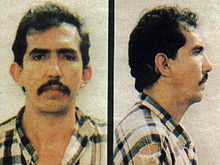Luis Garavito
| Luis Alfredo Garavito Cubillos | |
|---|---|
 Mug shot | |
| Born |
25 January 1957 Génova, Quindío, Colombia |
Criminal penalty | 22.1 years in prison |
| Killings | |
| Victims | 138 confirmed |
| Country | Colombia |
Date apprehended | 22 April 1999 |
Luis Alfredo Garavito Cubillos, a.k.a "La Bestia" ("The Beast") or "Tribilín" (American Spanish translation of Disney's "Goofy") (born 25 January 1957 in Génova, Quindío, Colombia) is a Colombian rapist and serial killer. In 1999, he admitted to the rape and murder of 147 young boys.[1] The number of his victims, based on the locations of skeletons listed on maps that Garavito drew in prison, could eventually exceed 300. He has been described by local media as "the world's worst serial killer" because of the high number of victims.[2]
Once captured, Garavito was subject to the maximum penalty available in Colombia, which was 30 years. However, as he confessed the crimes and helped authorities locate bodies, Colombian law allowed him to apply for special benefits, including a reduction of his sentence to 22 years and possibly an even earlier release for further cooperation and good behavior. Colombian law has since increased the maximum penalty to 60 years in prison.[3]
In subsequent years, Colombians have increasingly felt that due to Garavito's approaching early release, his sentence is not sufficient punishment for his crimes. Colombian law originally had no way to extend the sentence, because cases of serial killers like Garavito had no legal precedent in the country and thus the legal system could not properly address this case. In late 2006, however, a judicial review of the cases against Garavito in different local jurisdictions found that his sentence could be extended and his release delayed, due to the existence of crimes he did not admit to and for which he was not previously condemned.[citation needed]
Upbringing
Luis Alfredo Garavito was born on 25 January 1957 in Génova, Quindío, Colombia. He is the oldest of seven brothers and apparently suffered physical and emotional abuse at the hands of his father. In his testimony, he described being a victim of sexual abuse when young.
Murders
Garavito's victims were poor children, peasant children, or street children, between the ages of 8 and 16. Garavito approached them on the street or countryside and offered them gifts or small amounts of money. After gaining their trust, he took the children for a walk and when they got tired, he would take advantage of them. He then raped them, cut their throats, and usually dismembered their corpses. Most corpses showed signs of torture.[4]
Garavito was captured on 22 April 1999. He confessed to murdering 140 children. However, he is still under investigation for the murder of 172 children in more than 59 towns in Colombia.[5]
Sentencing
He was found guilty in 139 of the 172 cases; the others are ongoing. The sentences for these 139 cases add to 1,853 years and 9 days. Because of Colombian law restrictions, however, he cannot be imprisoned for more than 30 years. In addition, because he helped the authorities in finding the bodies, his sentence has been decreased to 22 years.[6]
Public response
As Garavito served his reduced sentence, many Colombians began to gradually criticize the possibility of his early release, some arguing that he deserved either life in prison or the death penalty, neither of which are applicable in Colombia.
In 2006, local TV host Pirry interviewed Garavito, which aired on 11 June of that same year. In this TV special, Pirry mentioned that during the interview, the killer tried to minimize his actions and expressed intent to start a political career in order to help abused children. Pirry also described Garavito's conditions in prison and commented that due to good behavior, Garavito could probably apply for early release within 3 years.[2]
After the Pirry interview aired, criticism of Garavito's situation gained increased notoriety in the media and in political circles. A judicial review of the cases against Garavito in different local jurisdictions found that his sentence could potentially be extended and his release delayed, because he would have to answer for unconfessed crimes separately, as they were not covered by his previous judicial process.[citation needed]
See also
Notes
- ↑ M. Benecke; A. Mätzler (September 2005). Two Homosexual Pedophile Sadistic Serial Killers:Jürgen Bartsch (Germany, 1946-1976) and Luis Alfredo Garavito Cubillos (Colombia, 1957) (in German) 125 (3). Minerva Medicolegale. pp. 153–169. Retrieved 20 June 2010.
- ↑ 2.0 2.1 "World: Americas: Colombian child killer confesses". BBC News (BBC Online Network). 30 October 1999. Retrieved 20 June 2010.
- ↑ "Rebajan la condena del asesino en serie Luis Alfredo Garavito". Retrieved 10 March 2010. (Spanish)
- ↑ (Benecke, pp. 161–162)
- ↑ (Benecke, p. 162)
- ↑ (Benecke, p. 166)
References
- CNN
- BBC
- Pirry entrevista a Luis Alfredo Garavito
- Fiscalia Report (Spanish)
- Two homosexual pedophile sadistic serial killers: Jürgen Bartsch (Germany, ∗1946 - †1976) and Luis Alfredo Garavito Cubillos (Colombia, ∗1957) (Minerva Medicolegale)